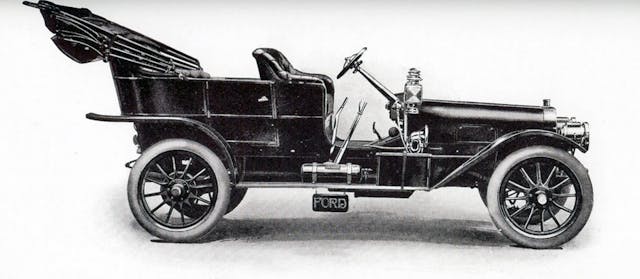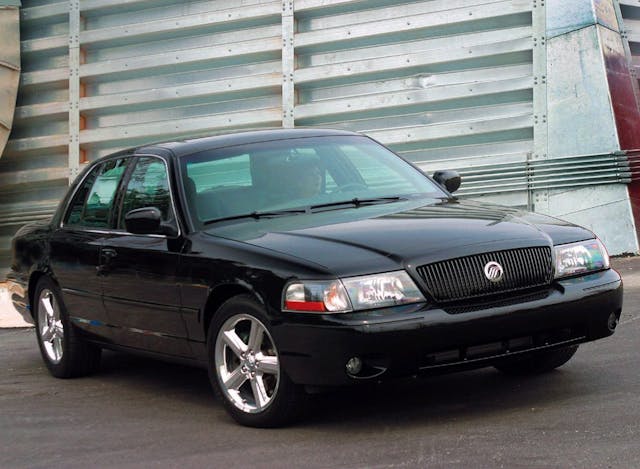10 flawed Fords that deserved a better fate
When Ford gets a vehicle right, it hits the nail on the proverbial head. Witness the F-150, the United States’ best-selling truck for 44 years straight, and the nation’s best-selling vehicle for 39. Ford even had the foresight to create the Mustang and, in successive years, to never stray far from the model’s roots and/or target demographic.
Then we have controversial cars like the Mustang Mach-E, which alludes to some historic blunders from the Blue Oval gang: When did Ford product planners steal defeat from the jaws of victory, much to the dismay of fans, investors, and Ford’s upper management? Some of the following examples may seem like a stretch, but there’s no doubt that each of these 10 Fords deserved a better fate.
Ford Carousel (1972)

Lee Iacocca has quite the track record in creating segment-busting vehicles, but the wildly successful minivan could have been a Ford victory. Iacocca was keen on making a “Garageable Family Van,” and the end result was the 1972 Ford Carousel, a heavily modified Econoline. (Ford and Ghia had other, more efficient variations on this theme that also predated the Chrysler minivan.)
But Ford passed on the minivan concept, allowing the recently departed Lee Iacocca and Hal Sperlich to resume their work at new gigs with Chrysler. While the 1972 Ford Carousel had no direct correlation to Chrysler’s minivan, Ford designer Dick Nesbitt has publicly stated: “The directive at Ford Design in 1972 was to create a van with automotive styling and a 2 1/2 inch lower roof to make it ‘garageable’ … The T-115 at Chrysler in the ’80s was based on the Ford Product Planning directive from 1972.” Too bad about that.
Lincoln Blackwood (2001–02)

The Blackwood had a mind-bending, distinctly un-truck-like posterior. The internet will lead you to believe this was a bad thing, but how many leased Range Rovers ever get a speck of dirt in their deep-pile-carpeted cargo holds? Contrary to popular belief, there’s a strong argument for a luxury truck that’ll haul nothing more than golf clubs like a C8 Corvette or Bloomy’s brown bags.
The Lincoln Navigator set suburban driveways ablaze in 1998, and Ford saw sense in pursuing the notion of truck-based luxury vehicles. So came the Blackwood, released as a concept in 1999 and approved for production due to positive public feedback. But delays ensured it didn’t make production until August 2001, a mere nine months before the second-generation Navigator was released for the 2003 model year. Park the new ’gator next to a Blackwood on a dealer lot, and it’s clear the old body style had a snowball’s chance in hell of success. Timing is everything in the car business: The Blackwood was tragically, inexcusably, unfashionably late to the party.
Ford Model K (1906–08)

There once was a time when all cars were as expensive as electric cars are today. (Let’s be real, even the Nissan Leaf isn’t exactly a bargain.) Cars were more of a luxury good, much like Tesla’s Model S electric luxury sedan was in the magical year of 2012. The (Tesla) Model S and (Ford) Model K parallel has merit: Both were powerful, prestigious, expensive and sold well. There’s a good chance that profits from the high-margin Model K fueled the development of the high-volume Model T. If true, the executive decision to kill the Model K (i.e., Henry Ford likely hated it) was akin to killing the goose that laid the golden eggs. But what if FoMoCo made the 1900s equivalent of F-150s and Lincoln Navigator Black Labels concurrently?
Mercury Marauder (2003–04)

While it didn’t peg the disappointment meter like the 1999 Mustang Cobra (which sported a similar 32-valve motor) did, the Mercury Marauder was significantly slower than its spiritual predecessor, the 1994–96 Chevrolet Impala SS. How can 302 hp be slower than 260? Sure, the Panther chassis had the goods at this point (big disc brakes, Watt’s link rear, hydroformed frame, a front clip perfect for hot rodders, etc.) and the Marauder’s disciplined suspension and modest cosmetic enhancements were arguably worth the premium (it stickered at $34,325).
However, tepid acceleration is a dealbreaker for many, and odds are the mea culpa upgrades given to the 1999 Cobra couldn’t save the Marauder from a bittersweet two-year production run. That said, the rumored supercharged S55 Marauder (presumably using the 2003 Cobra’s engine) would have changed the Marauder’s trajectory. If only Ford gave it the chance.
Edsel Comet (1960)

That’s right, the Comet was originally intended to be an Edsel. Perhaps the Edsel brand was doomed from the start, but could the all-new Comet have reinvented the brand for a new era of small-car-loving buyers? It’s not a bridge too far, as Ford previously remolded itself from the purveyor of the gargantuan Model K to the everyman’s hero with the Model T.
The Edsel Comet was a Ford Falcon with a longer wheelbase (sedans only) and tailfins worthy of a new design language for the Edsel brand. It symbolized a future that Ford rejected, however, as a last-minute change made the Comet a standalone vehicle sold at Lincoln-Mercury dealerships. The compact car with no “home” sold over 116,000 units in its first year, proving that even premium automakers were on board with making smaller, more efficient, more affordable vehicles. (Also note the 1961 Buick Skylark.) Isn’t it a shame that Edsel didn’t become a single-vehicle brand, represented by a precursor to cars like the Mercedes C-Class or BMW 3 Series, sold at Lincoln-Mercury dealerships, and subsequently offering a premium small-car ownership experience atop Ford’s solid engineering?
Ford Sport Trac Adrenalin (2008–10)

Ford’s midsize, crew-cab, plastic-bedded pickup survived for two generations and fostered a loyal following. What the Sport Trac lacked was a performance option, which was supposed to be resolved upon the release of the Sport Trac Adrenalin. The 2005 concept car was adrenalized with a custom body kit, 21-inch wheels, revised suspension tuning, all-wheel drive, a beefy six-speed automatic (from the Navigator), and a supercharged 32-valve V-8 likely robbed from the 2003 SVT Cobra.
Too bad the production version came out in 2007, reduced to a cosmetic upgrade accompanied by a naturally aspirated V-8 with three valves per cylinder. While it was a decent performer, it was neither a performance upgrade over any other V-8 Sport Trac nor a worthy bearer of the Adrenalin moniker.
25th Anniversary Ford Mustang (1989)

Legend has it that Ford’s Special Vehicle Operations (SVO) asked Jack Roush to make a Mustang that would out-gun the upcoming C4 Corvette ZR-1. The plan was to make it in time for the Mustang’s 25th Anniversary (mid-year 1989), which was also before Chevrolet planned on wowing the world with its homegrown exotic. So the team at Roush dropped a 5.8-liter V-8 with two small turbochargers in place of the 5.0, created a body kit surprisingly similar to that worn by the 1993 SVT Cobra, and generated enough torque to eat the Mustang’s T-5 gearbox and shake the lightweight Fox chassis to its core.
Perhaps it’s a good thing this ‘Stang didn’t come to life—or perhaps a naturally aspirated 5.8-liter pony (think Ford Lightning with a hotter cam) woulda been adequately safe and wholly appropriate for the Mustang’s silver anniversary. It’s definitely better than the retro dashboard emblem the Mustang got instead.
Ford/Mercury Cougar S (1999)

Perhaps you aren’t a Contour SVT nerd, and you don’t know about the 3.0-liter swap or the all-wheel-drive option on its European Mondeo counterpart. But the fine folks at Ford indeed knew, so they made the 1999 Cougar S concept car with the aforementioned powertrain upgrades readily available from their parts bin. The Cougar S also sported flared wheel arches, a subtle body kit, and seats with more aggressive bolstering. While an evolutionary dead-end thanks to the demise of the Ford Contour, the Cougar S came close to making production: Both the S’s unique engine cover and floor mats surfaced on eBay, offered by NOS Ford vendors liquidating their inventory. What a shame it didn’t come to life and eliminate the sport-compact competition!
Ford Taurus

This is actually a three-part failure, which bears testament to the Taurus’ longevity. Ford’s sedan savior was first subjected to years of product neglect, degrading incentive spending, and brand-eroding fleet sales that ultimately turned a revolutionary sedan into a rolling automotive punchline. Then, as an answer to a question nobody asked, the Taurus was killed and unceremoniously split into two unknown nameplates built on unique platforms, using unique parts, and assembled in separate factories. The Taurus returned as one of its two successors, only to be killed yet again in 2019.
The final chapter for this homegrown hero’s tragic tale involves the 2020 Mustang Mach-E, which is clearly the spiritual successor to the 1986 Taurus. (The Mach-E GT, by the same argument, is a reincarnated 1989 Taurus SHO). Yes, Ford’s electrified future shoulda been bred from the bull. Perhaps riskier than slapping the famous Mustang name on Ford’s GE1 platform, but as Eric Taub said in Taurus: The Making of the Car that Saved Ford, “If Ford is willing, as it did with the Taurus, to risk everything, it will find in the end that is has really risked nothing at all.”
Ranger FX4/FX4 Level II (2002–09)

Ford observed the popularity of its compact truck among right-sized off-roaders, and saw a chance to capitalize on the trend. Add Bilstein dampers, Alcoa wheels, Torsen 4.10:1 differential, short-throw shifter, beefy skid plates, manual transfer case, BF Goodrich all-terrain tires, and modest cosmetic upgrades to the workhorse Ranger … and the FX4 came to life.
While off-road performance was impressive thanks to the Ranger’s modest footprint, Ford muddied the off-roading waters (so to speak) with an unnecessary Level II upgrade (i.e. zero extra power) and mucked about with the performance parts (deleted the Alcoa wheels, swapped the Bilstein shocks for Ranchos) by 2008. The party was over in 2010, which is ironically the same year that the impressively massive F-150 Raptor made its debut.
Which flawed Fords would you add to this list? Let us know in the comments below.


